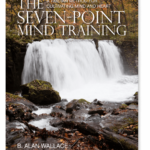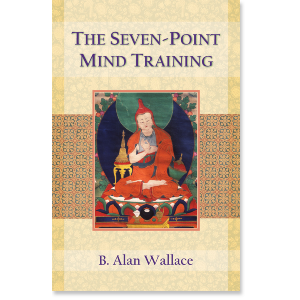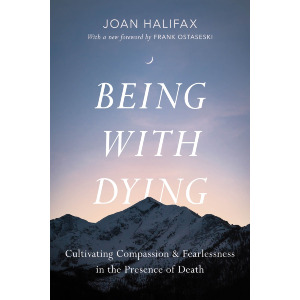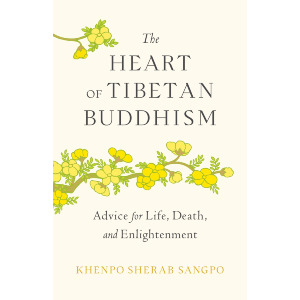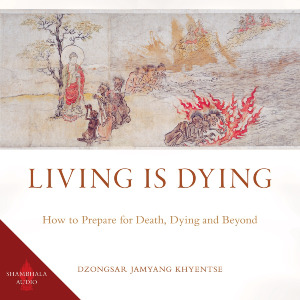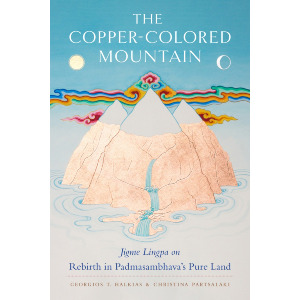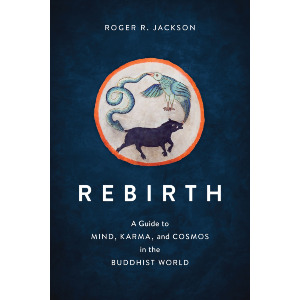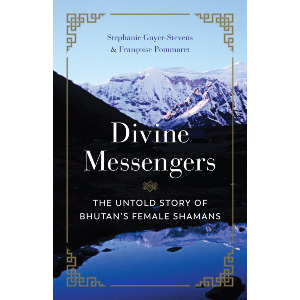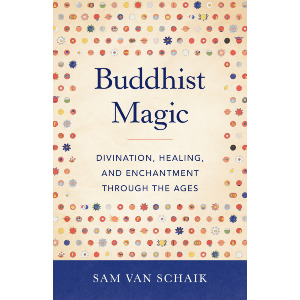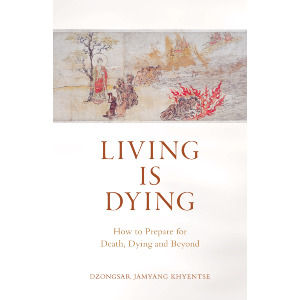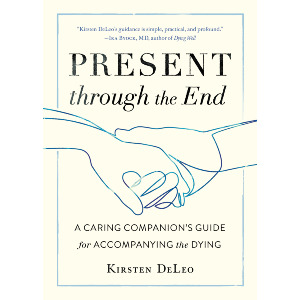| The following article is from the Winter, 2012 issue of the Snow Lion Newsletter and is for historical reference only. You can see this in context of the original newsletter here. |

The beauty of this Mahayana practice for the end of life is that it can be shared with friends and family who may not be Buddhist. This simple, five-aspected practice is adapted from
The Seven- Point Mind Training: A Tibetan Method for Cultivating Mind and Heart
At the end of a life devoted to Dharma, there comes a time for rounding off the practice. When we recognize that illness or simply old age has brought us very close to death, we can implement specific practices to influence the transfer of consciousness from this life to the next. The Tibetans have preserved a number of such practices, called phowa, working with energies associated with the transfer of consciousness. Most of these practices are taught in the context of Buddhist tantra, and they are often explained in relation to the bardo (the period following death and before the next life), as set forth, for instance, in the Tibetan Book of the Dead. But not many people are fully qualified to practice tantra.
The phowa practice based on the five powers presented here in the Mahayana context of the Mind Training is a non-tantric bodhisattva practice, which is more accessible for most people. We can keep this very practical and precious teaching in mind not only for ourselves, but also for loved ones who are not Buddhists, let alone advanced tantric practitioners. Reading the Tibetan Book of the Dead to a dying friend who is not interested in Buddhism will not likely be very helpful; sharing this practice may well be useful.
The state of mind just prior to death is most influential for determining the very next lifetime. Bringing our mind into a very wholesome state at this crucial time does not wipe out all the unwholesome actions that have gone before, but it does provide the most direct impetus for the rebirth immediately following. Conversely, if one should be so unfortunate as to die with an unwholesome mind, such as rage, this may well lead to an unfortunate existence in the next life. Once again, this does not mean that all the merit and favorable imprints accumulated through life are wasted, but they may be postponed for a lifetime or longer.
This method of transferring consciousness into favorable circumstances in the very next life entails five powers.
1. The power of the white seed. Here we are cultivating a white seed of virtue, which is interpreted here as release from attachment to our body and possessions. The Tibetan contemplative Gen Lamrimpa was once teaching this and chuckling as he spoke of how people acquire things, use them for a short time, then die and are reborn completely naked; then spend another life acquiring possessions only to die again, dead broke. On the threshold of death, if we are so fortunate as to anticipate its approach, it is very important to loosen our attachment to possessions: not only to give them away, but to really release them from our minds. We can give them as offerings to our spiritual mentor, to the Sangha, to our fellow Dharma practitioners, or to the poor. It hardly needs to be said that we should not leave the dregs of our belongings to those who have been kind to us. For our own welfare, we should release these attachments as we face death, and be free of them. They are no longer ours to use. If we can really set aside the attachment, especially just before death, we allow ourselves the freedom to dispense with a lot of fear, and more so if our lives have been devoted to Dharma to the best of our ability. We then have very little reason to be afraid.
2. The power of prayer.If we regret any unwholesome actions when we are about to die, this is the time to disclose or confess them and apply the four remedial powers. After purifying the mind, take refuge. Recognize that there is a source on which we can rely: the Buddha, the Dharma, the Sangha, the spiritual mentor. We are encouraged to make offerings in our mind's eye to the Triple Gem and to the Dharma protectors, praying: "May I remember and practice the two bo- dhicittas in the intermediate period between death and the next rebirth. May there be continuity, that I may meet in the next life with a holy spiritual mentor who teaches Dharma. I place my hope in you; make my way to joy a straight and clear one." Prayer is extremely important at this time, and will strongly influence the nature of one's death, the bardo, and the next life.
3. The power of abandonment.Recognize the self-grasping that clings to the body and to the self. Recognize that this fundamental distortion of the mind is responsible for the suffering that surrounds death, and as long as we remain subject to this self-grasping there is no true joy. Reject this clinging to the body and self for the remainder of this lifetime and in the coming bardo.
4. The power of resolution. This is not merely a prayer but a firm resolve to recollect the two bo- dhicittas during the approaching bardo: to recollect, on the one hand, the illusory nature of the experiences to comethat they are deceptive appearances of the mind and not intrinsically existentand, on the other hand, to recollect and practice relative bodhicitta in this time. Just prior to death, bring this to mind again and again with firm resolve.
5. The power of familiarization.Sechibuwa points out that the most important thing is to familiarize ourselves with the cultivation of the two bodhicittas without interruption throughout this life. Now, as this life draws to a close, he explains the most favorable posture in which to die. Lie on your right side, with your right hand under the right cheek, your little finger closing off the right nostril, and breathe through the left nostril. Because of its influence on the subtle energies coursing through the body, this is an excellent posture for engaging in the other meditations prior to death. In this posture, engage in the practice of taking and sending conjoined with the breath. Inhaling through the left nostril, draw the suffering and the sources of suffering of all sentient beings into your heart, vanquishing self- centeredness. As you exhale, send out white light of purity and loving kindness to all sentient beings and imagine it bringing them whatever they require: food, clothing, wealth, or spiritual teaching. Imagine them receiving all that they need and want.
Sechibuwa also speaks of a meditation in the same posture for the cultivation of ultimate bodhicitta just before death, which he encourages us to practice alternately with the taking and sending. This is a crucial time to recognize that all of existence, be it samsara or nirvana, consists of appearances to the mind that are not intrinsically existent. Recall that your own Buddha nature is not ultimately different from the mind of the Buddha and recognize the essentially divine nature of your own mind. Allow your mind to relax in this sphere of ultimate reality and, holding this awareness right to the point of death, recognize that for this ultimate nature there is no transference of consciousness; there is no motion.
When death comes, we have used up even our body. Shantideva tells us to regard the body as a loan for the duration of our lives, for us to use as an instrument in the service of others. Parts deteriorate from old age, or the whole may be crushed suddenly in an accident. Either way, it is time to release it and not to cling.
We can start practicing this now. The very strong attachment that we generally have to the body is what makes us so vulnerable to its suffering. After freeing attachment, generate the mind of fearlessness. We ourselves create much of the fear that surrounds death through our attachment to what we have to leave: our loved ones, our children, our possessions, our homeland, all the familiar things we are accustomed to. See if, during the course of life, we can enjoy these things but release the clinging to them.
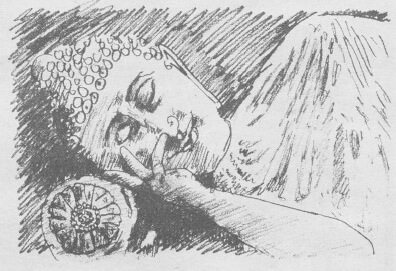
Lie on your right side, with your right hand under the right cheek, your little finger closing off the right nostril, and breathe through the left nostril. Because of its influence on the subtle energies coursing through the body, this is an excellent posture for engaging in the other meditations prior to death.
Strangely, it is often true that we yearn to speak about the mundane or degenerate characteristics of other people. Perhaps we feel uplifted by observing the faults of others, as if putting others down elevates our own sense of self-worth. Whether someone is untidy, or slothful, or bad at sports, the faults of others seem to place us in a more exalted light.
Within the context of Dharma, this inclination is stimulated as we receive teachings and begin to develop ideals about the transformation of our lives. Conversely, we may see ourselves lacking in terms of these same ideals, and this aggravates dissatisfaction. If we are prone to self-contempt or lack self-loveand I don't mean self-centeredness, but simply an affectionate acceptance of ourselvesthis may be exacerbated in the early stages of spiritual practice. As we become more aware of faults, we find more grounds for self-deprecation and disdain, which becomes an uncomfortable burden we carry around like a big bag of rocks. To be rid of even one rock would be a psychological relief.
We may try to unload some weight by directing awareness our own and others'away from our own faults. So we pick out the faults of others and talk about them: "Did you notice how Jack fidgets around when he is meditating? He can't sit still. His mind must be a whirlpool of confusion." Perhaps the most odious tendency is to compare ourselves favorably to others: "Did you notice how stingy Joe is? I have my problems too, but I have never acted like that."
Sechibuwa gives the blunt advice, "Don't speak of the mundane faults of others, nor of the faults of their spiritual practice." There may conceivably be very rare occasions when it is appropriate, provided that kindness is the motivation. Even more rarely would it be appropriate to speak of Joe's faults when Joe is not present. But how often when we speak of the faults of others is it really motivated by constructive kindness, by a yearning that the person may be free of this affliction? Perhaps not so often.

